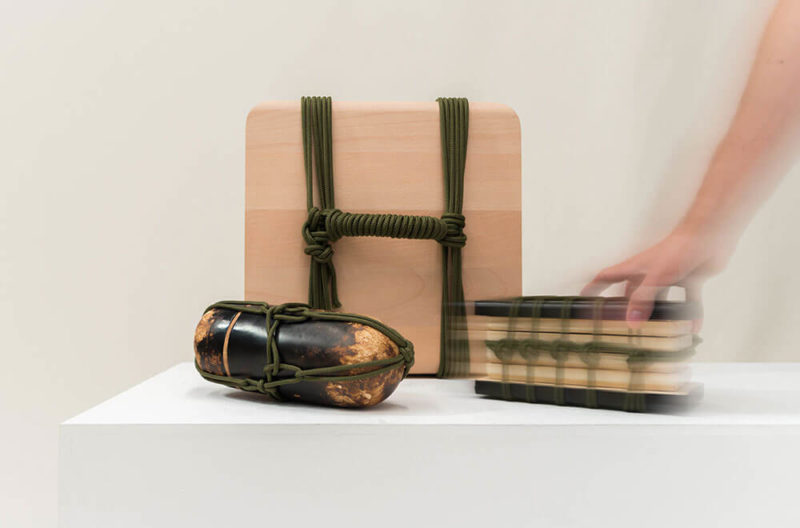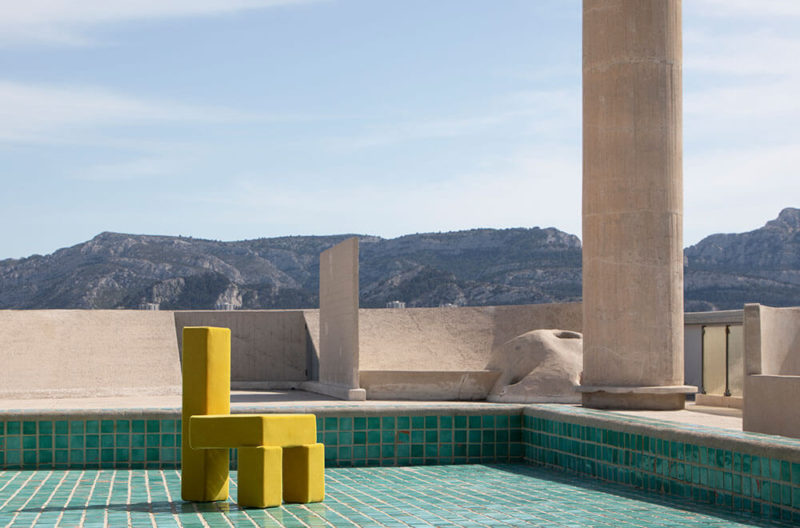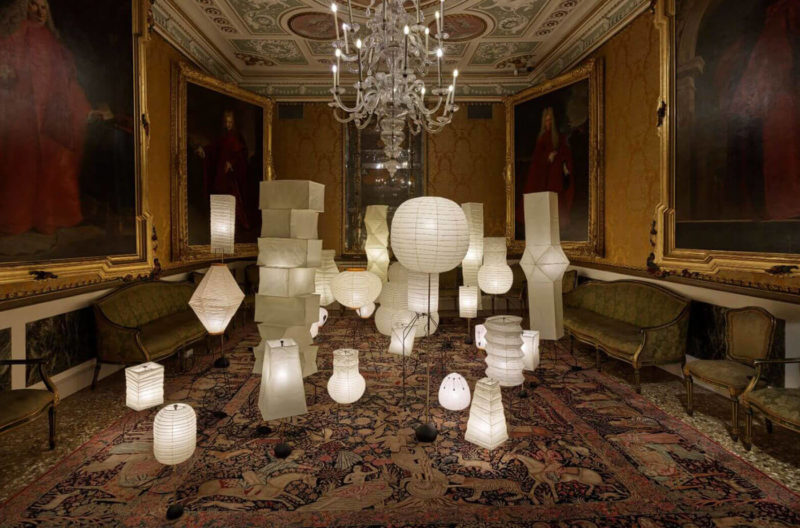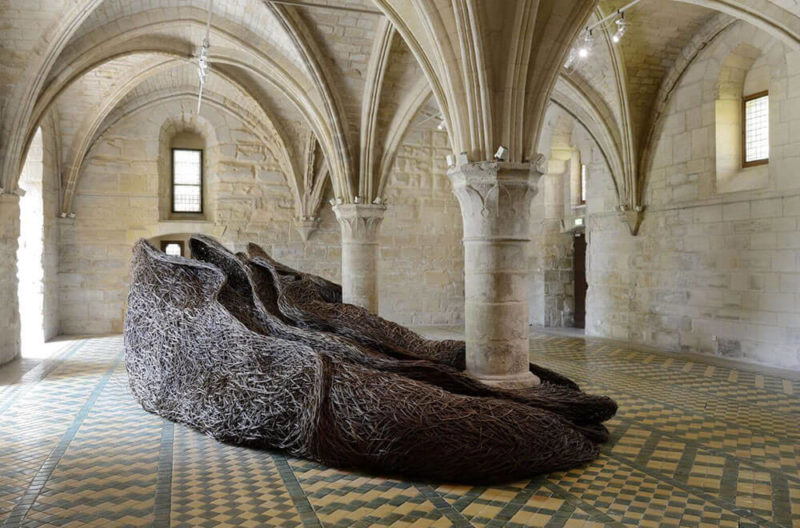Paris Dispatch / May 2022
Solo shows from Robert Wilson, Alvar Aalto and Martin Kippenberger, plus a magical decorative arts scenography fairyland from Galerie Chastel-Maréchal
Ketabi Bourdet: ‘Robert Wilson: A chair and its shadow’
Until 18th June 2022
Gokelaere & Robinson: ‘Alvar Aalto and the Maison Louis Carré’
Until 2nd July 2022
Skarstedt Gallery: ‘Martin Kippenberger: De Lumière et Sentiments’
Until 2nd July 2022
Galerie Chastel-Maréchal: ‘Féeries’
Until 4th June 2022

Alvar Aalto, (left to right) ‘Room Divider’, 1930; ‘Angel Wing Lamp’, 1954; ‘Paimio’ armchair, 1932
COURTESY: Alvar Aalto & Gokelaere & Robinson / PHOTOGRAPH: Yann Deret
Galerie Chastel-Maréchal
AS SPRING BRIGHTENS up Paris, galleries are curating imaginative exhibitions that arouse curiosity and stimulate the minds of viewers to recontextualise artworks with renewed perspectives. The four shows that The Design Edit focuses on this month all feature twentieth-century works that were radical at their time of creation and remain inspirational today. We take a look at chairs by American theatre director Robert Wilson, furniture and lighting by Finland’s Alvar Aalto, lamp sculptures by German artist Martin Kippenberger and an enchanted wonderland group show of decorative arts.
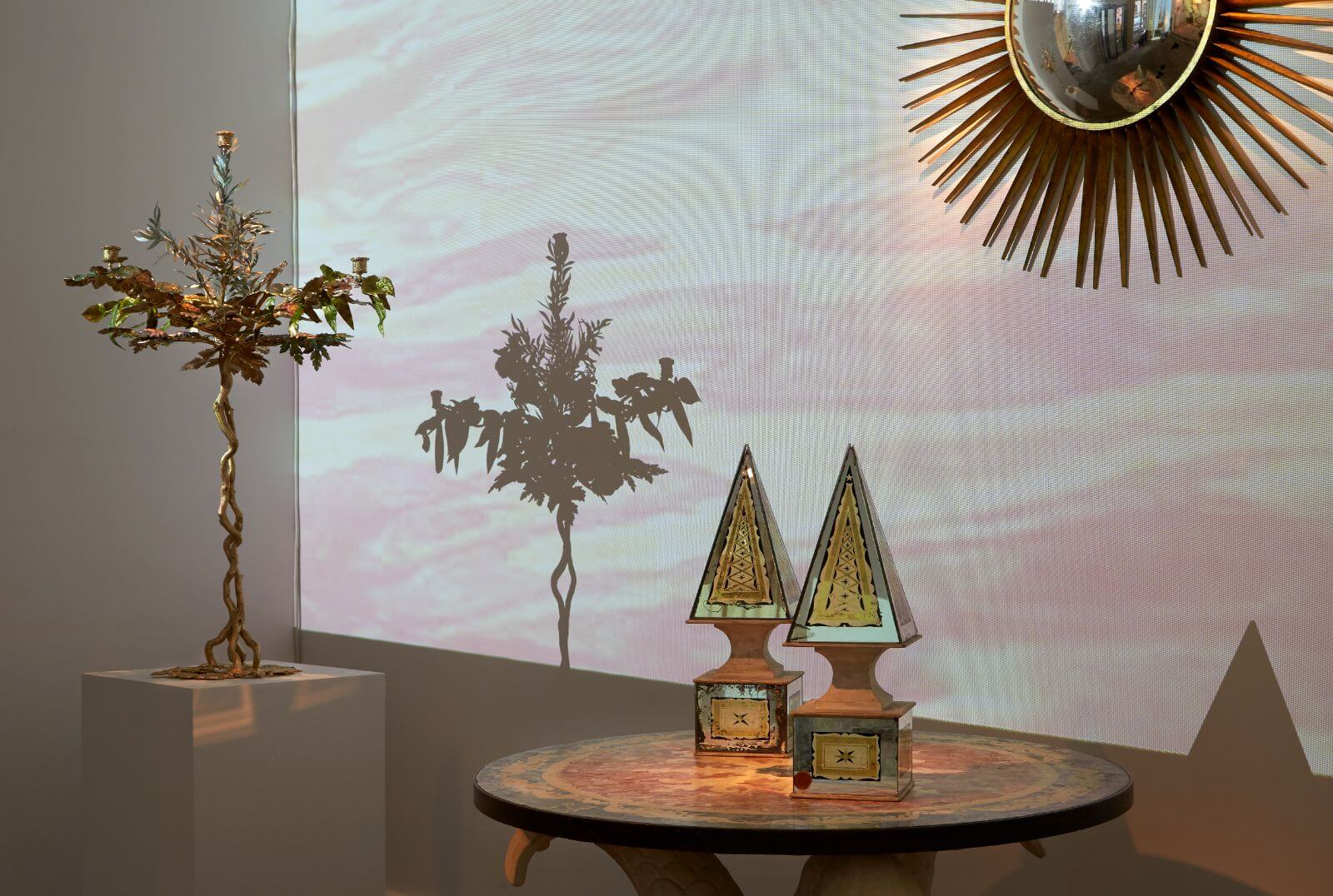
Exhibition view, ‘Féeries’ at Galerie Chastel-Maréchal
COURTESY: Galerie Chastel-Maréchal
Ketabi Bourdet: ‘Robert Wilson: A chair and its shadow’
This gem of an exhibition in Ketabi Bourdet’s intimate Left Bank space in Passage Dauphine spotlights furniture and drawings by American theatre director and visual artist Robert Wilson. Conceived for operas, the pieces on display are all elegantly imbued with dramaturgical qualities. For in Wilson’s hands, a chair can personify a figure and convey an emotional state like absence, loss or memory. “I take as much care in designing a chair as I do in creating a play,” Wilson has said. “All the details have to do with form and line, time and space.”
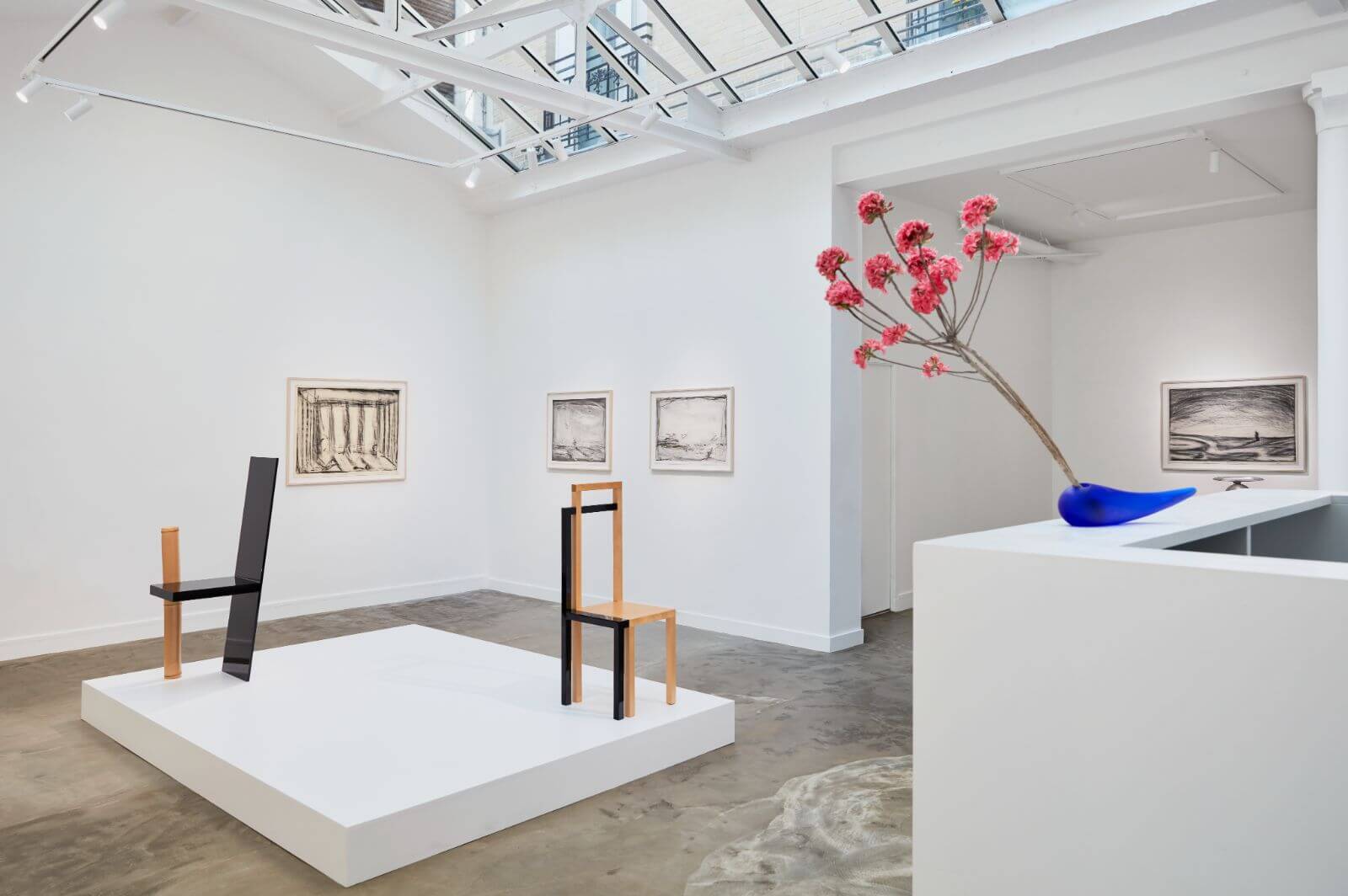
Installation view, ‘Robert Wilson: A chair and its shadow’ at Ketabi Bourdet
COURTESY: Bob Wilson & Ketabi Bourdet
The title of the exhibition, ‘A chair and its shadow’, borrows its name from a bleached birch chair with black lacquered shadow that Wilson created for the Los Angeles Opera production of Wagner’s Parsifal in 1987. Highly graphic and minimal, it is evocative of longing. On the same white podium is ‘Waiting Chair’ (1993), which Wilson designed for Madame Butterfly. With a bamboo branch at an oblique angle to the geometric form, it loosely brings to mind a hobbled person.
Elsewhere, a child’s stool – a Zen-like sculpture with spherical, hammered metal base and smooth glass surface joined by a black stone – rests on a plinth. Drawings by Wilson for his sets adorn the walls. Completing the selection are two examples of his ‘Hamletmachine Chair’ (1941) in perforated metal and a sculpture evoking a door left ajar.
In this deftly curated show, the gallery – founded last year by Charlotte Ketabi-Lebard and Paul Bourdet – highlights the role that furniture plays within Wilson’s overall vision for scenography.
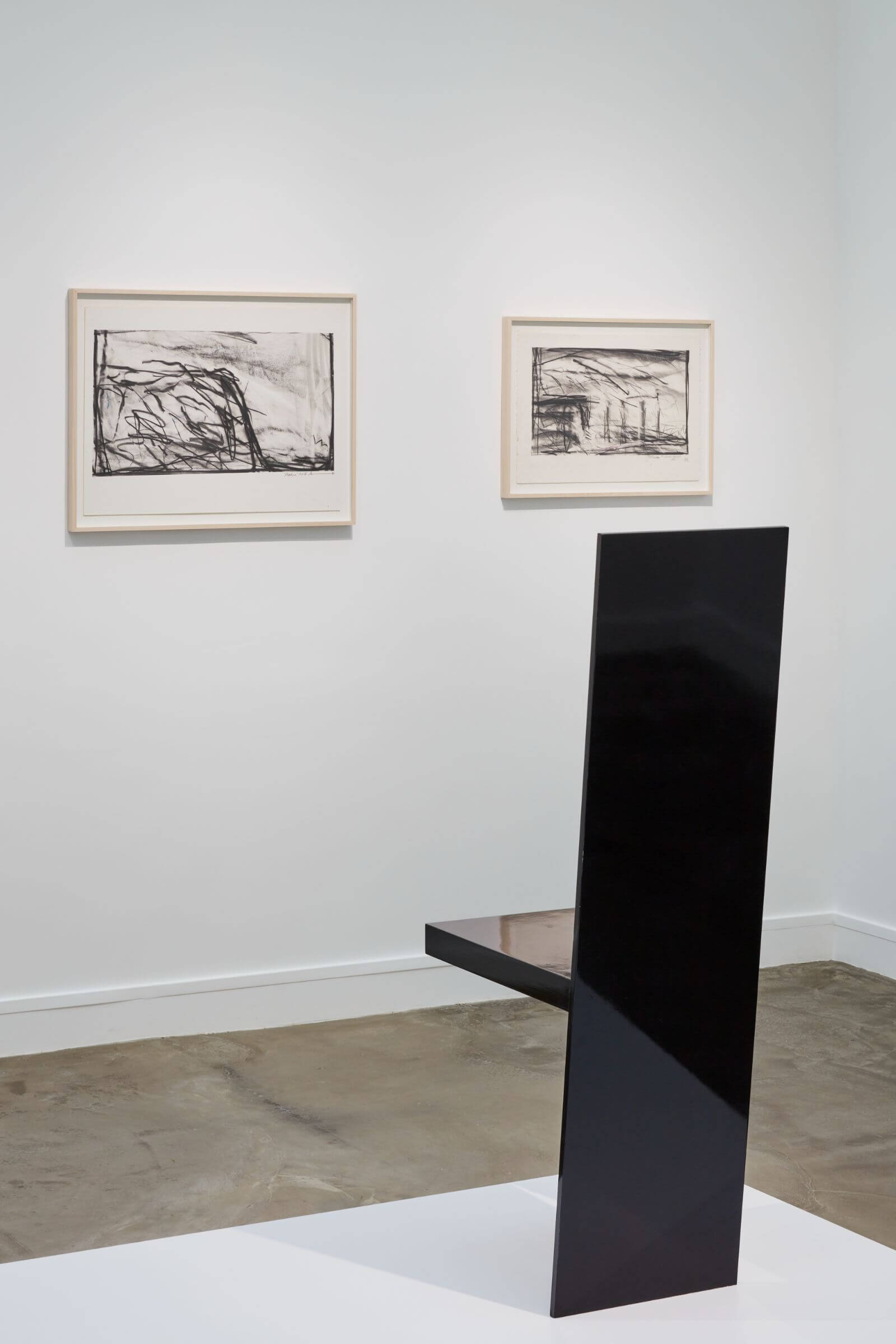
Exhibition view, ‘Robert Wilson: A chair and its shadow’ at Ketabi Bourdet
COURTESY: Bob Wilson & Ketabi Bourdet
Gokelaere & Robinson: ‘Alvar Aalto and the Maison Louis Carré’
Finnish architect Alvar Aalto designed only one project in France: Maison Louis Carré – a modernist villa in Bazoches-sur-Guyonne, a village southwest of Paris – for the art dealer and collector Louis Carré. Aalto also designed furniture and lighting for the house, which was filled with paintings by artists such as Picasso, Fernand Léger and André Lanskoy. This exhibition at Gokelaere & Robinson, the third since the gallery opened last October, presents Aalto’s work within a context similar to that of Maison Louis Carré.

Exhibition view, ‘Alvar Aalto and the Maison Louis Carré’ at Gokelaere & Robinson
COURTESY Alvar Aalto & Gokelaere & Robinson
Greeting visitors is Aalto’s undulating room divider, which recalls the wave-shaped pine ceiling at the entrance of Maison Louis Carré. There’s also Aalto’s iconic ‘Paimio Chair’ (1931-1932), whose bent and looped curves pushed the boundaries of plywood manufacturing, the white ‘Angel Wing’ light (1954) and the ‘Turnip’ pendant lamp (1950).
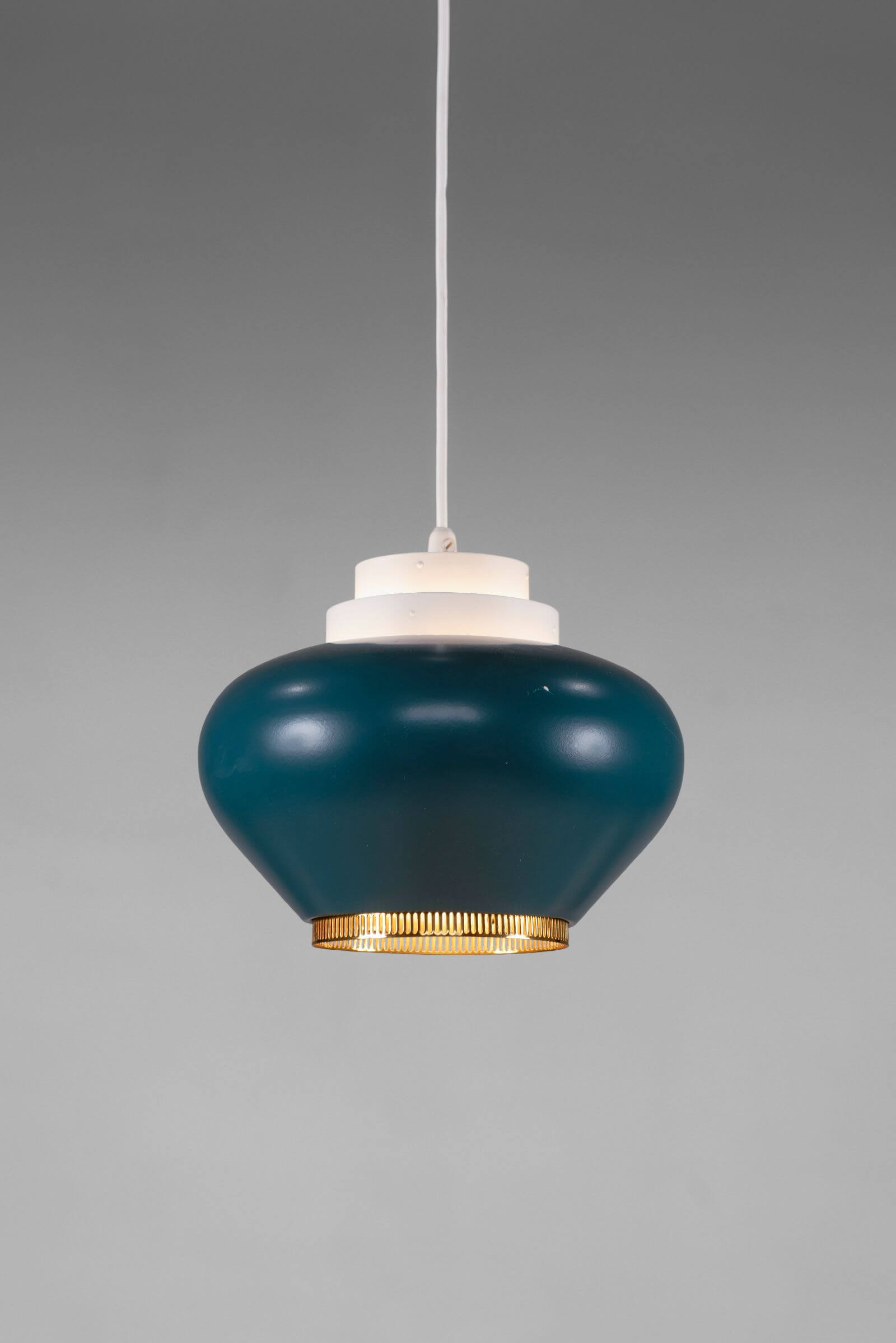
Alvar Aalto, ‘Turnip’ pendant lamp, circa 1950
COURTESY: Alvar Aalto & Gokelaere & Robinson
The gallery has paired Aalto’s works with several of Lanskoy’s paintings. For instance, a delightful green ‘Tea Trolley’ (1937) is displayed next to a red-toned collage by Lanskoy from 1959. Then in the adjoining room, Aalto’s ‘Aurinko’ (Sun-series) garden furniture, the table reminiscent of a daisy, is presented with Lanskoy’s pastel oil painting from 1961. The furniture set was created in 1938-1939 for Villa Mairea, which Aalto designed for Harry and Maire Gullichsen in Finland.
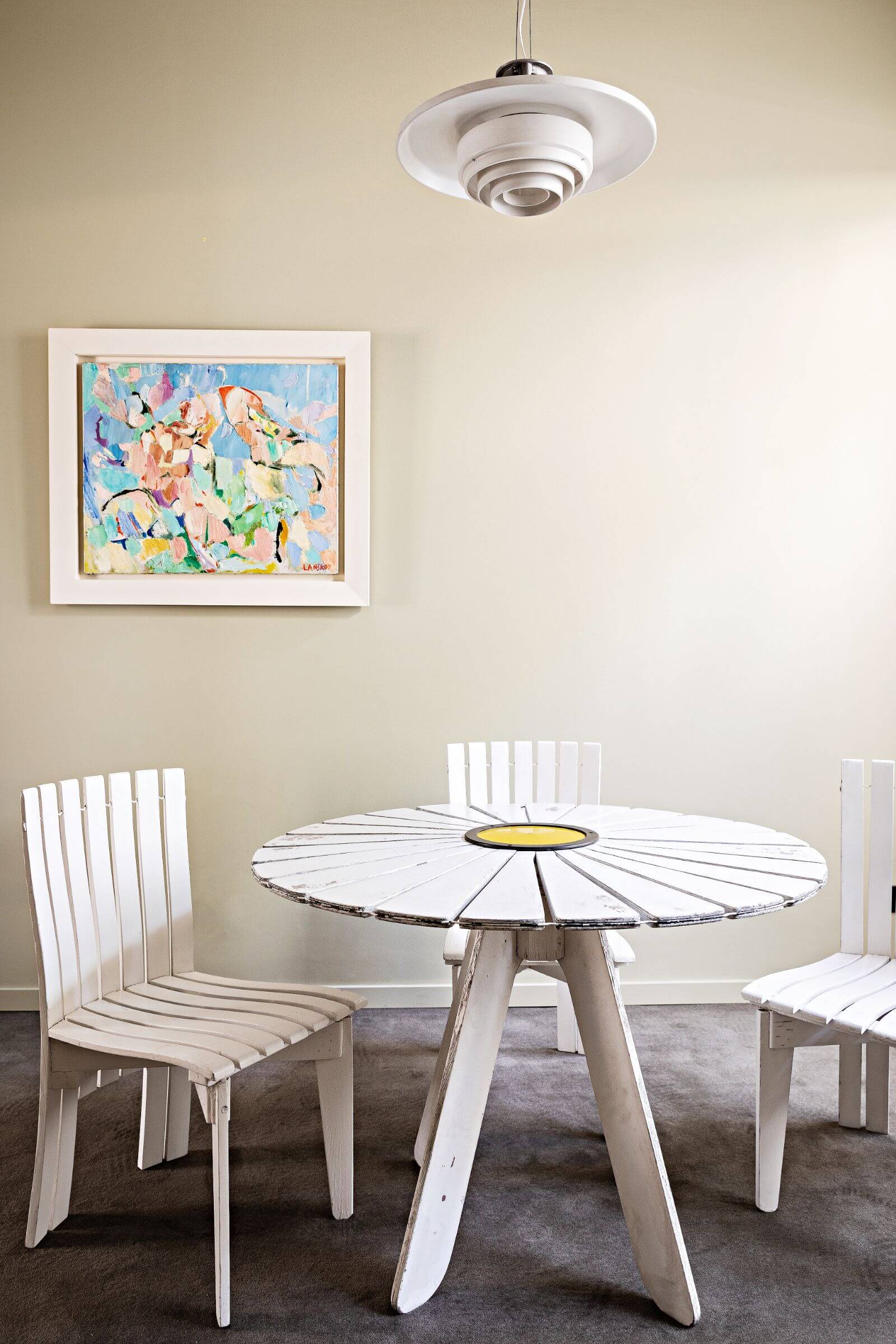
Alvar Aalto, ‘Garden chairs and table’, 1938-39
COURTESY: Alvar Aalto & Gokelaere & Robinson / PHOTOGRAPH: Yann Deret
Although several of Aalto’s pieces on view were not conceived for Maison Louis Carré, the show nonetheless contextualises Aalto’s graceful oeuvre in a faintly domestic setting.
Skarstedt Gallery: ‘Martin Kippenberger: De Lumière et Sentiments’
German artist Martin Kippenberger drew ideas from urban design and psychology to create artworks imbued with bravura. In this exhibition at Skarstedt Gallery – which inaugurated its Paris space last October, adding to existing spaces in London and New York – are several lamp sculptures and paintings, encompassing Kippenberger’s unifying vision of art and life.
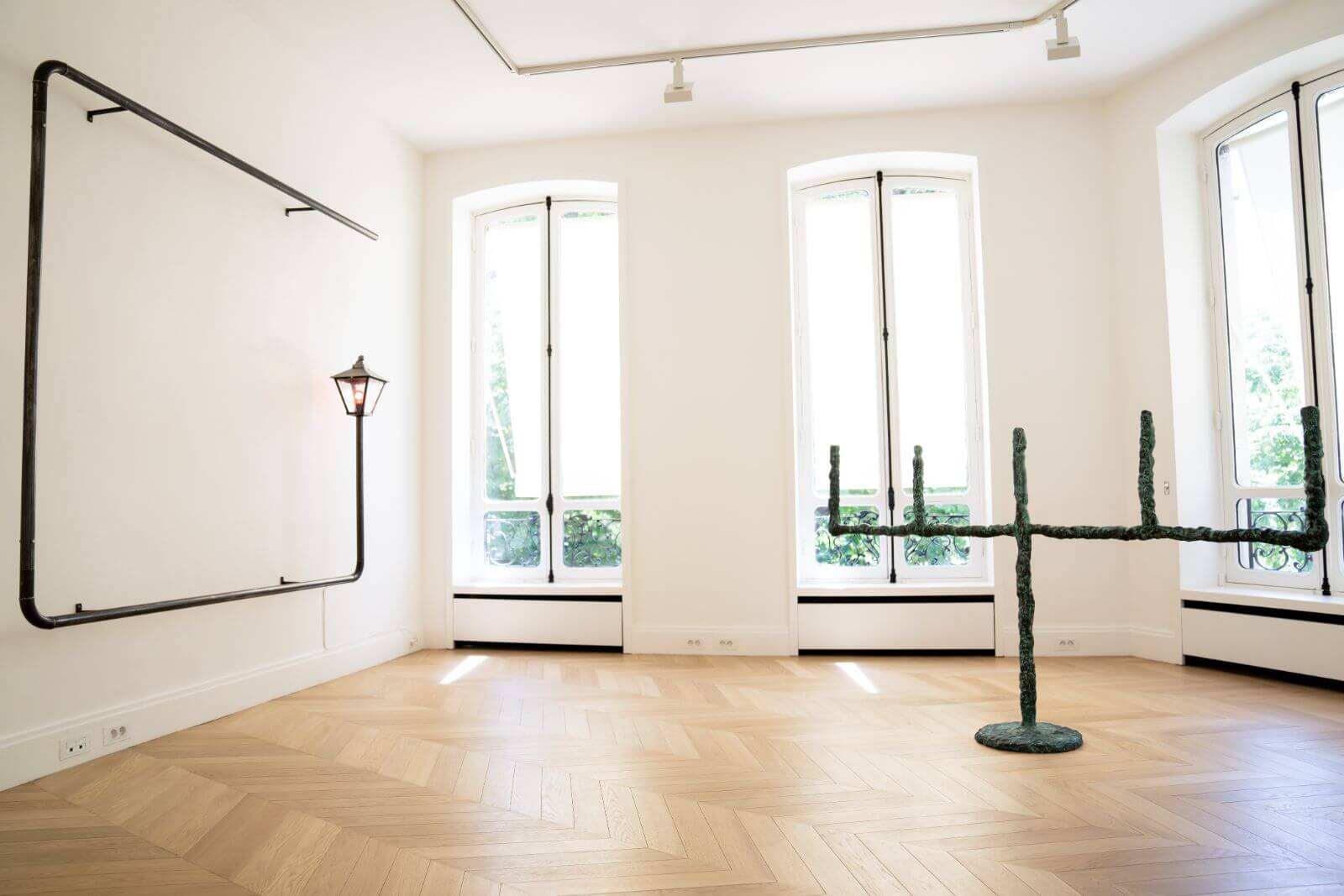
Exhibition view, ‘Martin Kippenberger, De Lumière et de Sentiments’ at Skarstedt
COURTESY: ⓒ Estate of Martin Kippenberger, Galerie Gisela Capitain, Cologne, Skarstedt Gallery/ ⓒ Benjamin Loyseau
The hard-partying Kippenberger made his first ‘Untitled’ lantern sculpture – a bent street lamp as a metaphor for a drunken person – in 1988, whilst living in Seville and Madrid. Titled ‘Laterne an Betrunkene’ (‘Street Lamp for Drunks’), it was resoundingly exhibited the same year at the Venice Biennale. While that piece is not on view, there are three others made in 1989. The first serpentines in and out of the wall on the first floor next to the staircase, seemingly integrated into the architecture. The second rises and curves into the ceiling, the lamp element appearing subversively not at the top but towards the bottom. The third snakes in an anti-clockwise direction along a wall, forming an incomplete, minimal rectangle with curved edges. The red bulb in each softly-lit piece alludes to red-light districts. Assuming a new purpose as artworks, or ‘psycho-lamps’, the witty lanterns blur the question of representation.
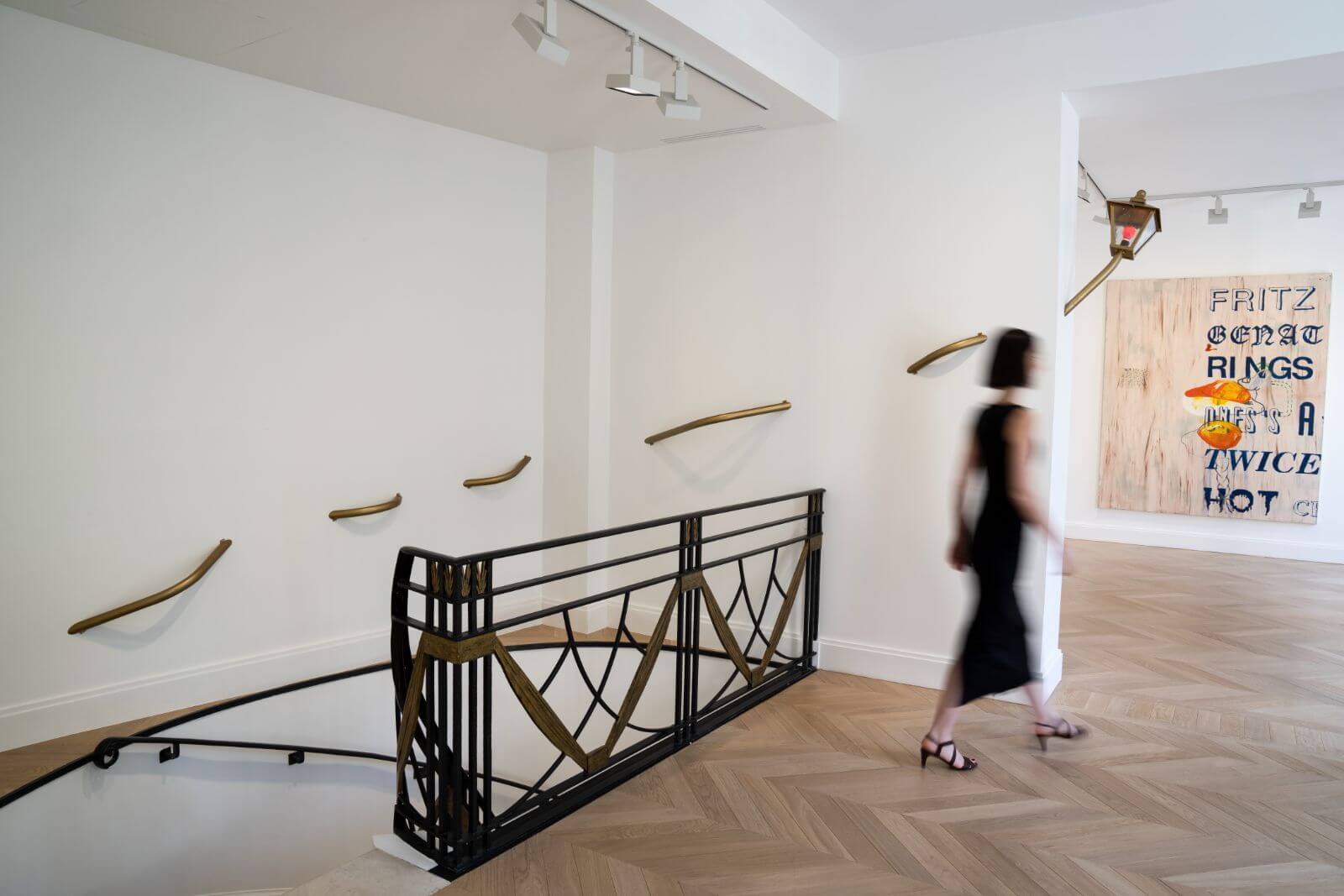
Exhibition view, ‘Martin Kippenberger, De Lumière et de Sentiments’ at Skarstedt
COURTESY: ⓒ Estate of Martin Kippenberger, Galerie Gisela Capitain, Cologne, Skarstedt Gallery/ ⓒ Benjamin Loyseau
Also on show are several paintings, one depicting a mirrored bed on an orange background, that Kippenberger created before dying from liver cancer at the tragically early age of 44.
Galerie Chastel-Maréchal: ‘Féeries’
An enchanted wonderland featuring 1930s’ Art Deco, works from the 1950s-1960s and contemporary creations lights up Galerie Chastel-Maréchal. Curated by gallerist Aline Chastel, it captures her love of reflective surfaces and animal-themed pieces in a scenography – complete with projections of a forest – evoking a magical glade where fairies may come out to play. The exhibition is aligned with the gallery’s longstanding commitment to decorative art forms, recalling its exhibitions of glass and mirror pieces in 2002, Line Vautrin in 2004 and a baroque universe in 2006.
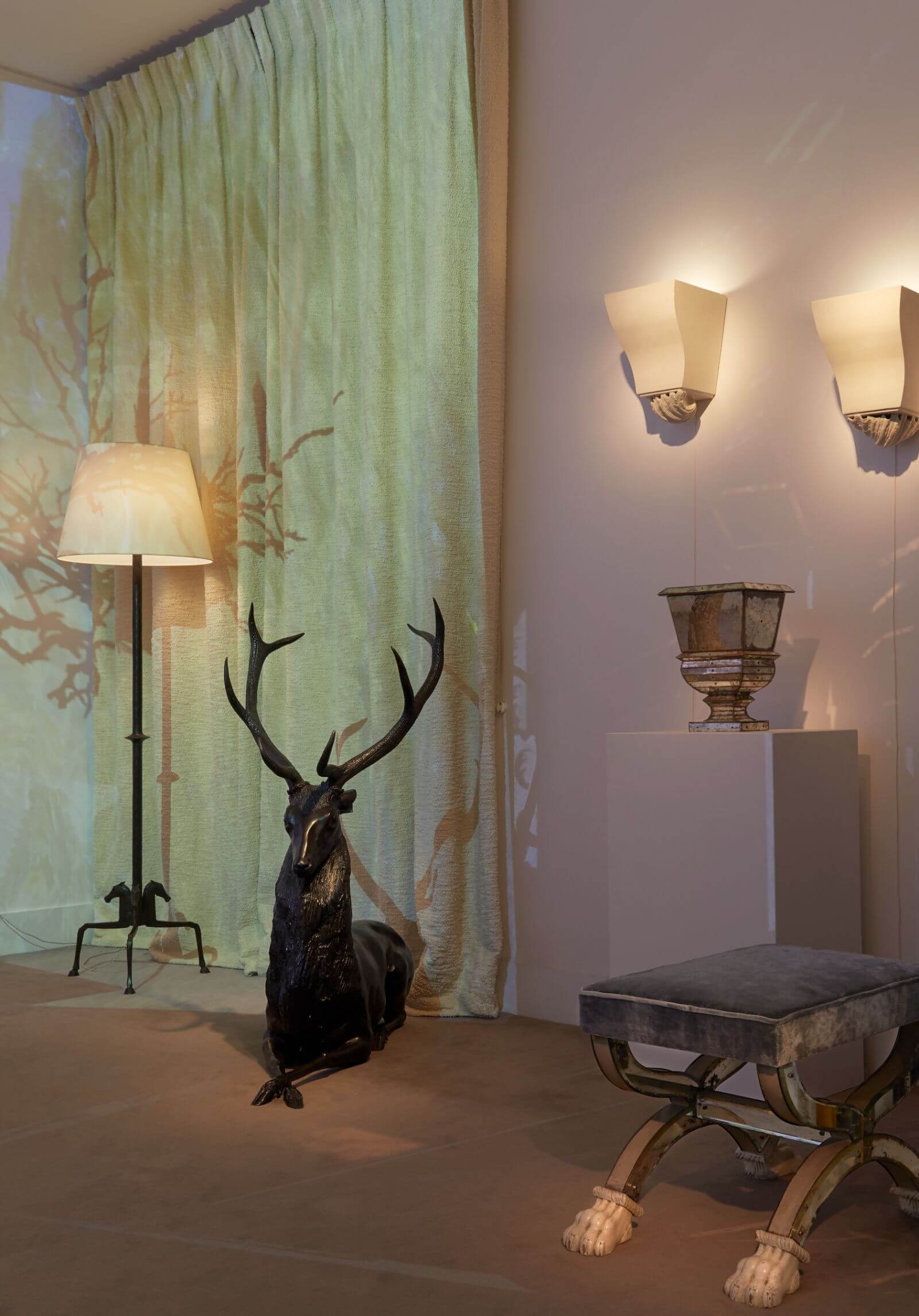
Exhibition view, ‘Féeries’ at Galerie Chastel-Maréchal
COURTESY: Galerie Chastel-Maréchal
Vautrin and Serge Roche both feature strongly. Beneath a constellation of Vautrin’s encrusted mirrors, Roche’s patinated mirror obelisks (1935) and black-and-silver ‘Celestial Globe’ made with his brother Camille (circa 1934) rest on his glass table supported by stucco dolphins.
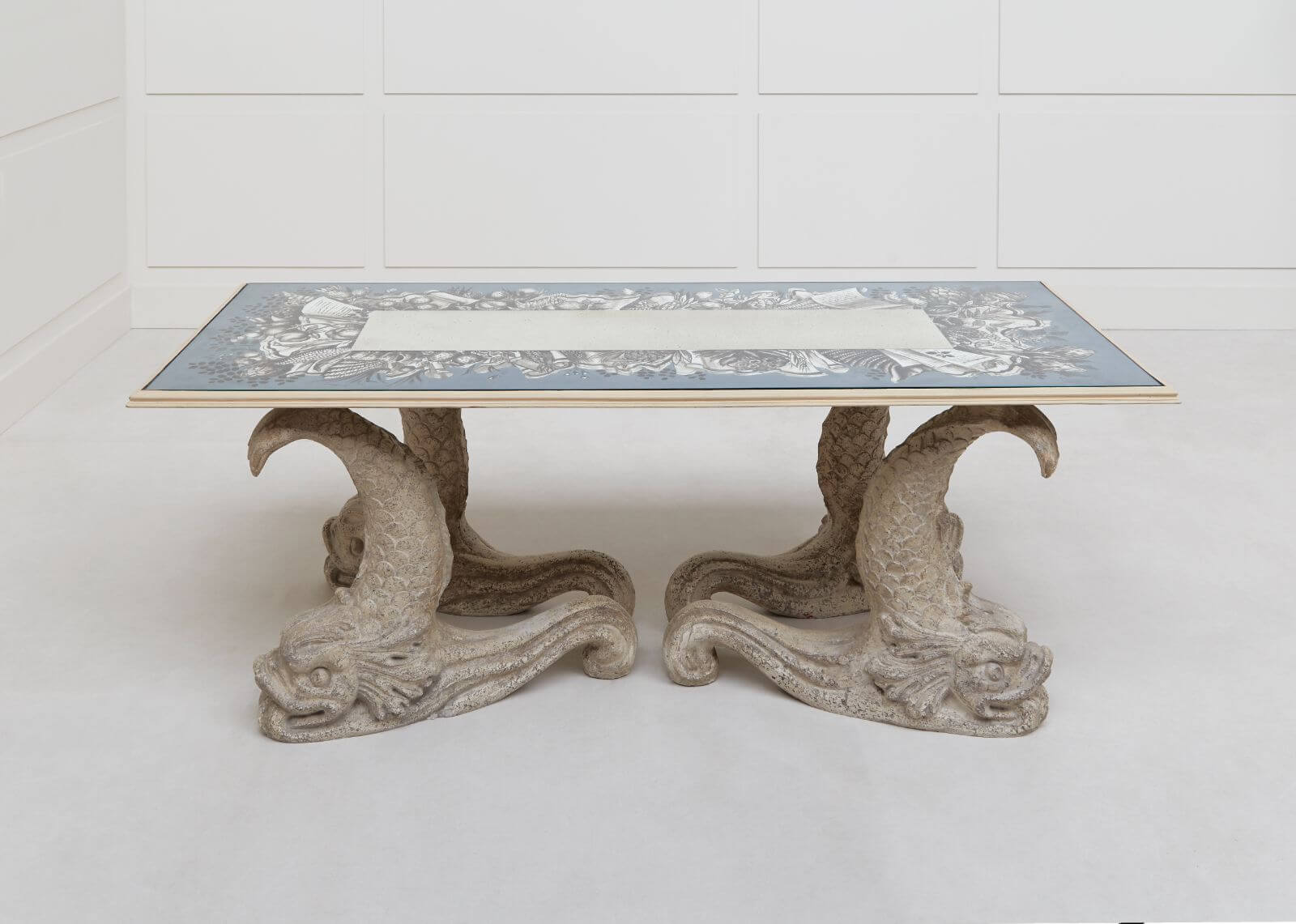
Serge Roche and Ismael de la Serna, ‘Table’, circa 1936
COURTESY: Galerie Chastel-Maréchal
Further along, Janine Janet’s beautiful bronze sculpture of a reclining stag, ‘Cerf Couché’ (1966), is situated next to Jean-Charles Moreux’s lamp (circa 1935), which is supported by horses’ heads, legs and hooves. Meanwhile, Gilbert Poillerat’s floor lamp (circa 1935), made from twisted wrought iron and stucco, is reflected in Max Ingrand’s panelled mirror from 1937.
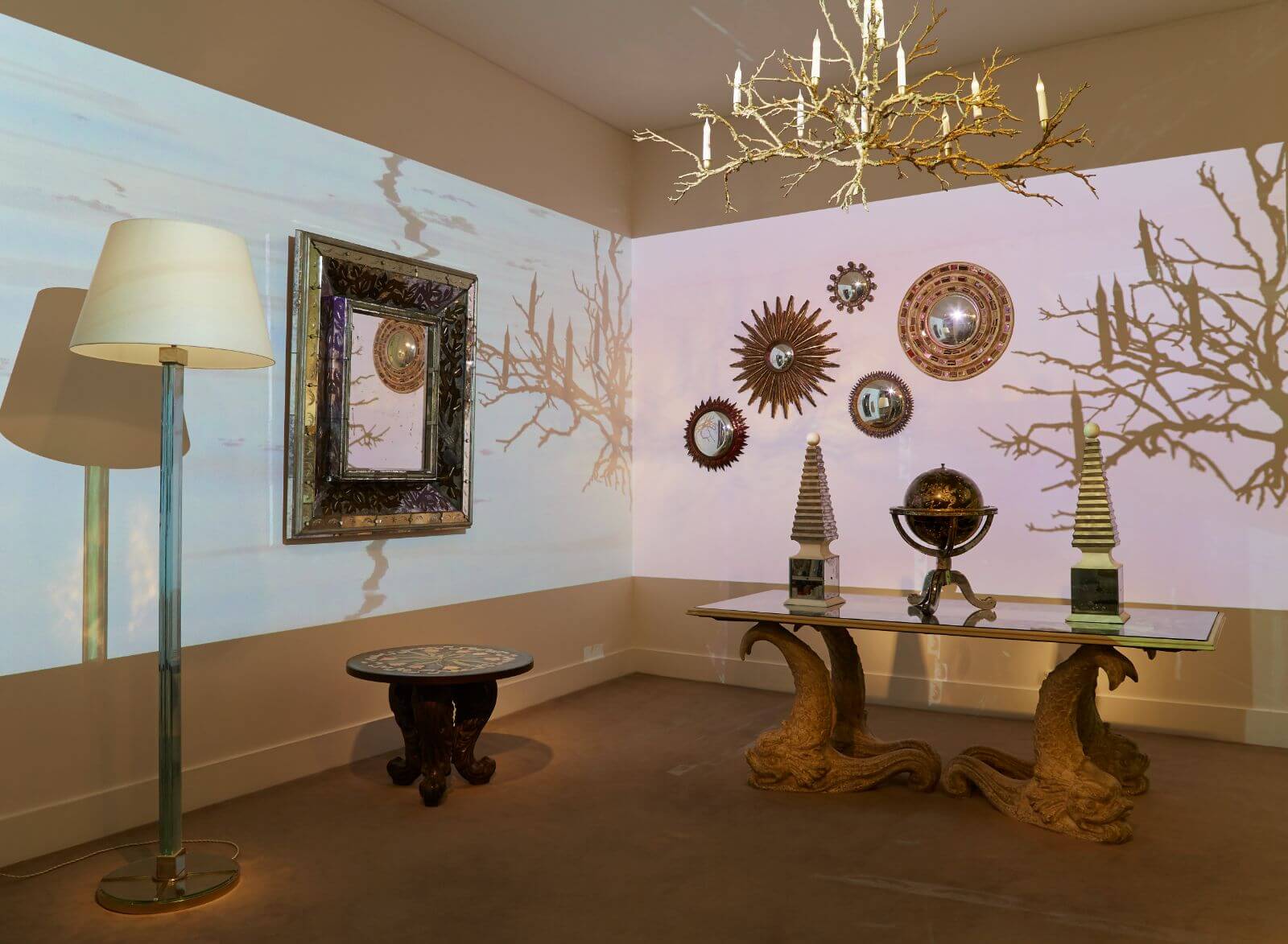
Exhibition view, ‘Féeries’ at Galerie Chastel-Maréchal
COURTESY: Galerie Chastel-Maréchal
Bringing the fairy and nature theme into the twenty-first century are two newly created works by French artist Joy de Rohan Chabot: a gilt bronze lamp with sunlit branches, ‘Un Arbre au soleil’ (2022), and a mirror festooned with branches and stars.
‘Robert Wilson: A chair and its shadow’ at Ketabi Bourdet, 22 Passage Dauphine, 75006 Paris.
‘Alvar Aalto and the Maison Louis Carré’ at Gokelaere & Robinson, 34 rue de Penthièvre, 75008 Paris.
‘Martin Kippenberger: De Lumière et Sentiments’ at Skarstedt Gallery, 2 Avenue Matignon, 75008 Paris.
‘Féeries’ at Galerie Chastel-Maréchal, 5 rue Bonaparte, 75006 Paris.




